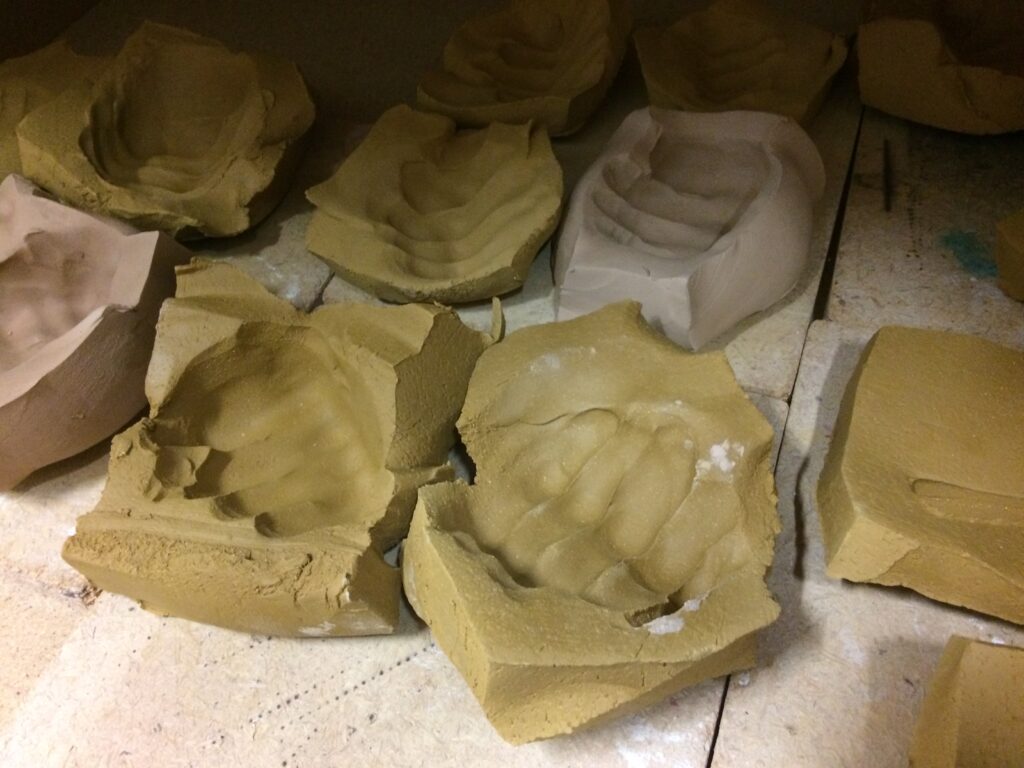
Art-intervention proposal for Jewish Week, Leipzig June 2017:
“My name is Nobody”.
A Clay Odyssey – an artistic response to the Holocaust and contemporary issues of Hospitality.
Project Proposal for Jewish Week Leipzig, (June 2017)
Background:
Leipzig is the city in which my mother was born. I visited the city again for the fourth time in 3 years in early June 2016; I had been invited as the descendent of people born in Leipzig of Jewish parentage, murdered by the Nazis in the Holocaust; this was the fate of my grand-parents.
While in the city I had a series of meetings with the organisers of Jewish week that will occur in June 2017, to develop an intervention. I wish to create a positive experience out of the recognition that much has been achieved in terms of reconciliation. Thus I shall propose a symbolic re-interpretation of two of the fundamental concepts employed by the Nazi regime – of Clay (Erde) and Fire. The Nazis developed the concept of Blut und Erde to represent the sacrifice needed for the new Reich, by returning to the land; it was a symbol of extreme nationalism and exclusion. We shall use these materials and processes in an alternative way: Earth/Clay to make elements that represent the coming together and acceptance of difference amongst peoples: religious, sexual, political; by pressing clay between our hands when we encounter the other (zusamenstücke) in meeting we shall re-fashion a bit of mud, and when that is placed in a ceramic-kiln fire it can be made permanent, rock-like and can last thousands of years – longer than the history of civilization and longer even than the anticipated Third Reich! Fire is the other significant element; it has two dimensions: the Nazis used it as the agent of purification – in destruction and killing and the disposal of bodies; but Fire can also be the site of a coming-together and contemplation. We shall use the symbolic idea of fire as a place of comfort, enjoyment and warmth to counteract the negative impulses of the Nazis in burning books and burning people; we can re-appropriate the idea of fire to cleanse through a coming-together of peoples, remembering the past while forging new meanings.
—————-
Theoretical foundations:
My work can be understood within a phenomenological framework established by continental European and Jewish philosophers; this is initially provided by the insights of Maurice Merleau-Ponty, who primarily demonstrates that individual subjectivity is indissoluble from the body (this is an understanding central to a maker concerned with the significance of hapticity). Richard Shusterman, provides an explication of the way in which a study of hand-made objects can be a tool through which we can shape our lives, and Emmanuel Levinas explains how the “face of the other” must be an essential determinant in evaluating all action within an ethical framework.
—————-
The title of the work: My name is Nobody – Clay Odyssey, reflects the theme of Hospitality embodied in the invitation to me from the city of Leipzig to return to the place of my mother’s birth, which was also the site of the removal of my grandparents by the Nazis to be murdered. Like the travels and travails of the Homeric Greek Odysseus, addressed ideas of journey and hospitality. These are reflected in the narrative of Odysseus/Ulysses as he voyages around the Aegean, planning his return to Ithaca. Odysseus is a man, looking to return home, while his home has been appropriated by ‘guests’, who did not follow the basic rules of hospitality. On his travels Odysseus has many encounters (with Nausicaa, Circe, etc.) which offer him the opportunity to be a good guest; in some of these encounters he behaves well and in others his own actions are seen to be wanting! In others the duties of the host are seen to be lacking – Polyphemous, the Cyclops, kills and eats Odysseus’s men, a symbolic presaging of the Holocaust. Odysseus manages to blind the sleeping giant with a fire-hardened stick, and when Polyphemous wakes in agony and asks who has plunged him into darkness, wily Odysseus answers: “My name is Nobody.” Thus when asked by his fellow giants , Polyphemous tells them: “Nobody did this to me”.
The title: My name is Nobody – Clay Odyssey allows us all to view ourselves as immigrants, since our ancestors all came from elsewhere, even if our families have lived in the same place for generations. The association of Homer’s Ulysses/Odysseus travelling by boat seems congruent with the experience of the new migrants. The other famous Ulysses association that I conjured with was that of Leopold Bloom; in the novel, Ulysses by James Joyce, he is the itinerant Jewish anti-hero, who is ‘at home’ but alienated.
My name is Nobody – Clay Odyssey glanced backwards at the terrible events of the last century, and the total failure of the Nazis to behave like civilized hosts. It also critically examined, through art-creation and performative art-making, the present situation in Europe, where there are again many displaced persons: some are seeking sanctuary, (like my mother found in the UK on the Kindertransport). Others are economic migrants seeking a better life than the ones they left behind. My grandparents arrived in Leipzig in the early 1900’s – it was a place that welcomed them; they were distant from the pogroms that had engulfed their lives in Eastern Poland. Ton Odyssey addressed the issues of that time (when the Jews tried to assimilate, and many Germans showed great hospitality, while some did not); it additionally focused on the current situation of asylum seekers, refugees and economic migrants who are all seeking a better and safer life in Europe/Germany/the UK. Theoretically it considered the ways in which “the other” is dealt with by cultures, mediating that reception through the use of clay (dug from the Earth). Assisted by clay artist Anna Gsänger, I worked with, refugees, who in the main had escapes from the conflicts in the Middle East.